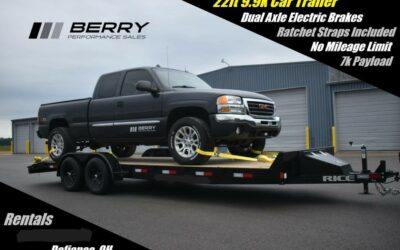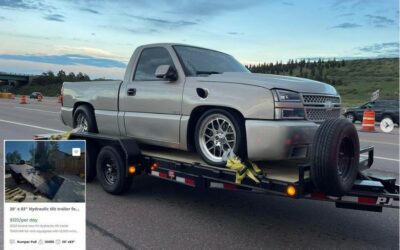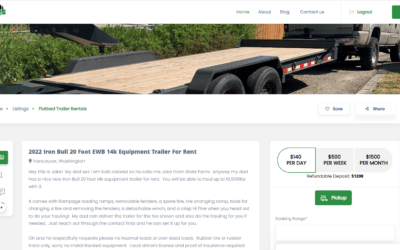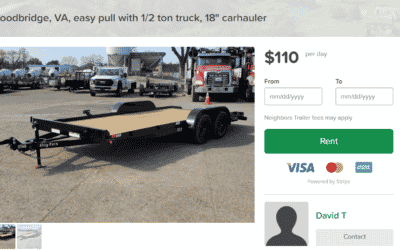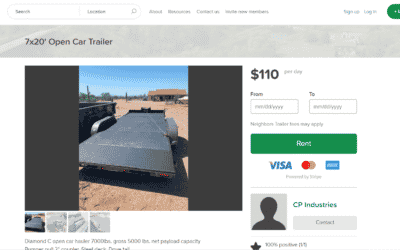Written by Neighbors Trailer
Trailers make the transportation of bulky items incredibly easy. Whether you want to ship cargo to a different city or state, a trailer can carry all the weight smoothly and quickly across great distances. Nevertheless, the challenging and tiresome step of correctly loading a trailer is the first step in this long journey. Here’s all you need to learn about safe ways to load a trailer before you move on to securing the cargo and hitting the road.
The loading process may seem straightforward but entails efficient cargo placement and complicated weight distribution that you must figure out before placing items in your trailer. You must also figure out how much weight your trailer and the towing vehicle can withstand. This will help you manage and define the optimal weight distribution and help you avoid any unexpected mishaps along the way.
If you would like any help regarding trailer loading or are a first-time hauler, a reputable trailer rental marketplace or service, such as Neighbors Trailer, can guide you regarding best practices in the industry.
Calculation of Trailer Weight and Towing Capacity
The first step to safely loading a trailer is calculating exactly how much load you can put on it. The next few steps will teach you how to determine your vehicles’ Gross Trailer Weight Rating (GTWR) and Gross Vehicle Weight Rating (GVWR), calculate the possible weight to be carried, and the best way to distribute cargo.
- Check your vehicle’s Gross Trailer Weight Rating (GTWR)
A vehicle’s Gross Trailer Weight Rating determines precisely how much weight it can carry, including the passengers, cargo, and attachments. You can find the GTWR number on the inner side of the driver’s side door or the windshield. It is usually placed near the Vehicle Identification Number (VIN). You should never exceed the vehicle’s GTWR since it can result in high strain on the brakes, transmission, engine, or other systems. Overloading can also be potentially life-threatening since it can cause permanent damage or fatal accidents.
- Check the Gross Vehicle Weight Rating (GVWR) for your trailer
You need to know your trailer’s Gross Vehicle Weight Rating to determine its maximum load when it is loaded. You can find this number in the product literature or description or even on a sticker on the trailer itself.
- Calculate the possible weight that can be carried
If you know the trailer’s weight, you simply need to subtract it from the GVWR. This will give you the amount of weight you can carry safely. If you do not know the trailer’s weight, you will need to measure it at a location with a certified scale.
- Weigh the trailer’s tongue to determine the best cargo placement
More safe ways to load a trailer include determining the weight of the trailer’s tongue after calculating the total possible weight to be carried. Figuring out the trailer’s tongue weight will help you figure out how much weight you can put in each trailer section.
The trailer’s tongue is the part-metal shaft that connects the back of the vehicle to the trailer. In the best-case scenario, the tongue’s weight should be 10-15% of its overall weight after loading. A too heavy tongue could cause issues in maneuvering the vehicle, while a lighter tongue could result in the trailer swaying away while steering a curve.
Load Distribution and Cargo Placement
- Target a 60 to 40% weight distribution towards the front
When you begin placing weight towards the front of the trailer, aim to place 60% of the items at the front of the vehicle. The remaining 40% should be placed at the back for proper weight distribution. This ratio helps manage cargo load and is critical for safe driving since it reduces the risk of cargo shifting and the contents of the trailer or trailer swaying once on the road.
The rule is applicable for both open and enclosed trailers. You shouldn’t get overly technical with the ratio but just focus on putting more weight in the front and driving carefully to avoid any problems.
- Consider the shape and weight of items for cargo placement
If you are moving top-heavy items such as dressers and display cabinets, you should place them at the front. This will ensure that they do not dive and are much easier to tie down. The heaviest items of the cargo must be placed in the middle to increase stability. This will provide support to the top-heavy items in the front and pack it all close together to prevent sliding and shifting.
The remaining smaller items must be placed at the back of the cargo, with the heaviest placed below and lighter objects on top of it. You should ensure to balance the items from front to back and top to bottom in the back of your trailer.
Securing the Cargo Load
After you have placed all your cargo on the trailer, the next step is to secure the items using nylon webbing straps, ropes, or chains. You should place the ties every 5-10 feet on your cargo tautly using the attachment points available on either side of the trailer. You can wrap excess material to reduce any slack present and even place lengthwise ties if you are worried about taller items falling over. The number of ties you need depends on the kind of cargo you carry. Larger items require a minimum of 3 to 4 ties, whereas 1 to 2 ties would be perfect for small-medium-sized items that don’t pose a risk of falling over.
Final Thoughts
Buying, loading, and securing a trailer is not an easy job and certainly can’t be done by a single person. Neighbors Trailer, a trailer rental marketplace, can help ease the worries of small business owners and people who are in need of transporting heavy cargo by offering a variety of trailers for rent at an affordable price.
Whether you want to rent a horse trailer or a semi-trailer, you can find one by poring over our various listings or by leaving a rental request. To learn more about the marketplace, Contact Neighbors Trailer to discuss your unique needs with us today.
Did You Know We Get Over 1100 Trailer Rental Leads Per Day?
We want to send business your way!
Related Articles
Fully-Loaded Mobile Car Wash and Detail Trailers for Rent in Atlanta, GA
Setting up a car wash and detailing business typically requires a massive investment, but if you are based in Atlanta, GA, and willing to think outside the box, there’s a great opportunity for you.
Car Hauler Trailer for Rent in Defiance, OH
Are you traveling from one place to another and have two vehicles to take with you without a driver for the second car? You can always hire a professional transportation company. Of course, you must understand that it will be expensive. Since you’re already driving...
Hydraulic Tilt Flatbed Trailer for Rent in Denver CO
Do you need to haul a car, equipment, or various other types of cargo from time to time? Renting might be the best way to go. Buying a high-quality trailer fit for various applications is expensive. Finding a place to park it and paying for its maintenance, especially...
Equipment Trailer Rental Vancouver, WA
Rent this trailer from a dog named Jake in Vancouver, WA.
Car Trailer Rental in Woodbridge VA
If you find the need for the occasional use of a car trailer, renting may be your best option. The cost of purchasing a trailer, finding a place to park it, and the maintenance to be performed, are all issues the new trailer owners must consider. At Neighbors...
Car Trailer Rental in Queen Creek AZ
A car trailer can be hard to find and expensive to buy. At Neighbors Trailer we have fixed that problem and made trailers easy to find and rent nationwide and cut out the cost of a purchase.
Stay Up to Date With The Latest News & Updates
Join For Free
Search for rentals or list your own trailer rental.
Join Our Newsletter



